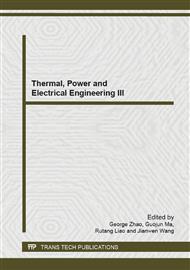p.485
p.488
p.493
p.498
p.503
p.513
p.517
p.523
p.528
China's Thermal Power Generation Forecasting Based on Generalized Weng Model
Abstract:
Since the 21st century, China's power industry has been developing very quickly, and the generated electrical energy has been growing rapidly. Although nuclear power, wind power, solar power generations have been increased, thermal power generation still accounts for more than 80% of the total generating capacity. Thermal power provides an important material basis for the development of the national economy. Therefore, the prediction research on China's thermal power generation trend is becoming a topic of great interest. The fuel of thermal power generation-coal, is an exhaustible resource. Due to the exhaustible constraints the fuel, thermal power generation trend is bound to show a similar trend bell curve as the coal production trend, similar to a bell-shaped curve—a gradual increase to maximum output and then a short peak and a gradual decline. To get more accurate results of future thermal power generation, this paper applies the generalized Weng model to forecast China's thermal power generation peak and trend. The result indicted that the peak of China's thermal power generation appears in 2022 with generating capacity of 51,702 TWh. The generating capacity of thermal power will decrease gradually after 2022. Based on the results, the paper proposes some policy recommendations for the sustainable development of China's electrical energy. China should decrease the percentage of the capacity which comes from thermal generation and reduce the dependence on thermal power generation. Moreover, nuclear, hydraulic, wind and solar power should be developed before the thermal power generation peak.
Info:
Periodical:
Pages:
503-509
Citation:
Online since:
June 2014
Authors:
Price:
Сopyright:
© 2014 Trans Tech Publications Ltd. All Rights Reserved
Share:
Citation:


